
In my last post, I had mentioned about upcoming camping trips this summer. Here is our first one this year to the Yosemite National Parks. We went for a 1 night 2 day camping trip with friends.

The weather was just perfect, not too cold and not too hot. We left Oakland around 9 a.m. and arrived at the Crane Flat Campground by 1 p.m. Our camp site was quite spacious and was surrounded by a wall of sequoia trees and a beautiful meadow right next to it.

After we set up our tents, we had beef salami sandwiches with avocado spread on focaccia bread and watermelon for lunch. And then we went on hiking to the Tuolumne Meadows. Though this was my third time to the Yosemite, I had never been to this part of the park, so I was very looking forward to the trip. After driving for about 40 minutes on Tioga Pass Road, a breathtaking view of open prairie came into view with a backdrop of mountain range. It was a totally unexpected and different view from what I used to see in the valley. This reminded me of why people keep coming back to the Yosemite over and over again; the park offers a different experience every time we come. The meadow looked so peaceful and beautiful.


We stopped by the Tolumune Meadows Visitor Center to ask for a not-too-long-but-beautiful-trail nearby. Per their recommendation, we decided to hike a short portion of the famous John Muir Trail to the Twin Bridge. On the trail we came across a creek, then a rocky but not-too-steep path, and about 30 minutes into the trail, beautiful sight of grass meadow with river running right in front of it came into view. Then everybody started clicking cameras in all directions. It was such a lovely place to be.

After this, we decided to check out the Soda Spring trail that was nearby. It was also a short and beautiful trail with some surprises. We ran into dears and other wild animals along the way. As the name of trail suggests, there is a shallow spring of carbonated water which used to provide mineral-rich water to native Indians in the area in the old days. The area near the spring is covered with reddish mud and small amount of water bubbled up all over. The water, which we were told was safe to drink, had a very strong iron aftertaste.


Hiking is fun, but when it comes to camping I am most excited about preparing and having dinner. And on this trip, dinner was definitely the highlight of the trip. The menu for the night was samgyupsal (sliced pork belly meat) and chadolbaegi (thinly sliced beef brisket). There is something about eating outdoors that makes me want to see and hear foods sizzle in front of my eye. We had two grill pans going at the same time, so we can grill samgyupsal and chadolbaegi at the same time. To accompany the meat, I also prepared kimchi chigae, Korean lettuce, gaenip (sesame leaves), ssamjang, and scallion salad. We were all very hungry after we returned from hiking. Korean BBQ dinner after a (half) day of hiking was, as a Korean saying goes, "like everything was glazed with honey". So delicious. We almost forgot to take pictures, but luckily I remembered to take some pictures this time. After dinner we sat around the camp fire and continued on with desserts - roasted corns, sweet potatoes and s'mores.
Whenever I go camping, I feel that spending time in the nature provides so much boost of energy to our life that no urban life can offer. I think I got a pretty good dose of that energy this time. It was a short but fun and memorable trip that definitely made me want to come back again.

A few weeks ago we went hiking with a group of friends to Tomales Point in the Marin County, about 40 miles north of San Francisco. It was the first hiking trip for this year, and I was so happy to be finally able to pursue outdoor activities after several months of hibernation through not-too-cold but very wet California winter weather.

I love going on a weekend trip to the Marin Headlands. Whenever we come to visit this part of our town, I am awe-struck at how much beauty can be present in one place and time. Any bubbles of worries and stress seem to evaporate from us when we breathe in the fresh air here. We always tell ourselves that this is one of the reasons we can't leave the Bay Area despite the high cost of living and being away from our families.
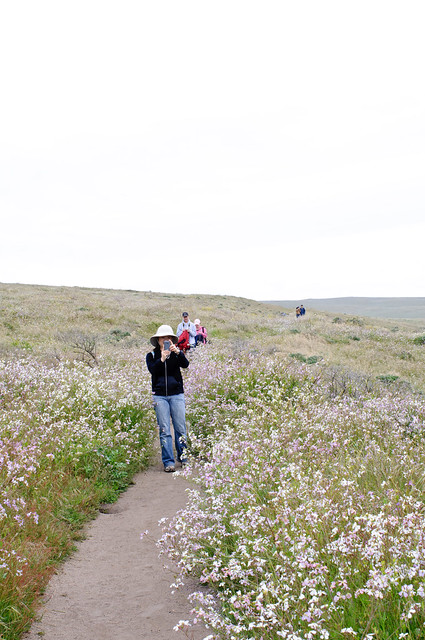
This was our first time on the Tomales Point trail. It's not fair to compare one trail to another because they are all natural wonders, but in my opinion the Tomales Point trail was one of the most beautiful trails I have been to thus far. The trail gently rises and falls, passing through a vast field of wild flowers and grass against a backdrop of the Pacific Ocean. When we got there in the last week of May, the wild flowers were blooming up to our waist high. I felt so tempted to free-fall to my back onto these flowers. It would've been totally like a scene from a movie.

About half way into the trail, we met a herd of elks that were freely roaming the field not too distant from the trail. They didn't seem to bother our presence at all. This reminded us they are the hosts and we are only visitors to this part of land.

About three quarters into the trail, the horizon off the Pacific Ocean started getting dark, and gray clouds ascended first from the ocean and slowly towards us. What seemed to be a drizzle at first turned into a pouring rain. So we reluctantly decided to turn back. With no place to shelter under but a few a few groves of pine trees along the way, we got soaking wet by the time we came back to the trail head. It was getting cold, too. On the way back, we unanimously agreed to have hot noodle soup for dinner. So we headed to Saigon Pho in Albany. Nothing could have warmed us up better than a hot bowl of noodle soup.
The first hiking trip for this year started out as rather memorable. Thankfully, none of our friends or we caught a cold from the trip. After that I felt very proud of myself for being so fit! I think I am ready for more eventful activities this summer.
도토리묵국수[do-to-ri-mook-gook-soo]
When we were in Korea last fall, we had mooksabal, acorn tofu noodle soup for the first time and fell in love with it instantly. We had had acorn tofu (dotori mook) before but never seen a noodle soup made with it. When we first read about it, our reaction was how can they make noodle with acorn tofu?! (For those who are wondering how they make tofu out of acorns, check out this wikipedia site.) So we were very anxious to try it.

We had arrived in the Incheon Airport the night before. We rented a car from the airport and drove to Yanpyoung, a small rural/resort town just east of Seoul. We picked Yanpyoung as our first destination because it is not too far from Seoul and is en route to the East coast - we planned to visit the East coast this time since we toured the west and south coasts during our last trip. Yanpyoung is also quite famous for a wide variety of epicurian dining options like wild vegetable bibimbap, azuki bean porridge, Hanwoo (Korean beef) BBQ, etc. Among many, acorn tofu noodle soup is a popular must-try dish in the area.

We drove around the town taking pictures until the restaurant opened. Though Yanpyoung is only 40 miles from Seoul, the air in this part of the country was so fresh that I could feel the crispy winter air deep in my lung. It was quiet and peaceful here except for sounds from roosters and dogs. The streets were empty except for heavy morning fog which engulfed the whole town.
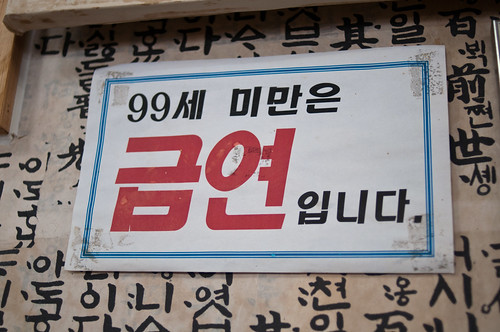
We were the first customers when the restaurant finally opened. We sat on the heated floor where a sign was hanging which read "NO SMOKING FOR 99 YEARS OLD OR YOUNGER." The menu was very simple with only a handful of items which were all made with acorns in some form or another, including acorn pancake rolls, acorn tofu noodle soup, acorn tofu bibimbap, and so forth. We ordered the pancake rolls and noodle soup. They were filled with strong nutty flavors of acorns, and needless to say, were very delicious.
After we came back to the States, we set a plan to replicate the meal with the acorn flour we have at home. I did some research online and finally made it. The memories of heavy morning fog and snow-covered pastoral landscape of Yanpyoung came back along with the first bite of home-made acorn noodle soup.
Ingredients for 2 servings:
acorn tofu (1 block, size of standard size tofu)
kimchi (1 cup, chopped and seasoned with a dash of sesame oil and ground sesame seeds)
egg (1, hard boiled and cut in half) scallion
roasted seaweed (1/2 piece, shredded)
anchovy (6, large)
kelp (1, 2"x2")
daikon radish (1/3)
dry shitake (3)
Korean soy sauce (2 tbl)
water (6 cup)
Seasoning Sauce:
soy sauce (3 tbl)
scallion (1 stalk, chopped)
garlic (1 tsp, minced)
chili powder (1 tbl)
sesame oil (1 tsp)
ground sesame seeds (1 tbl)
1.
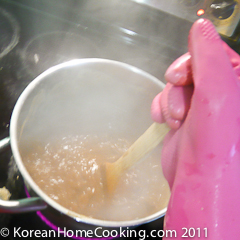 You can buy the tofu directly from a market or make it from scratch using acorn flour like I am doing here. If you are using acorn flour, mix 1 cup of acorn flour in 6 cups of water with a dash of salt and then boil over low to medium heat for 20 minutes stirring constantly.
You can buy the tofu directly from a market or make it from scratch using acorn flour like I am doing here. If you are using acorn flour, mix 1 cup of acorn flour in 6 cups of water with a dash of salt and then boil over low to medium heat for 20 minutes stirring constantly.
2.
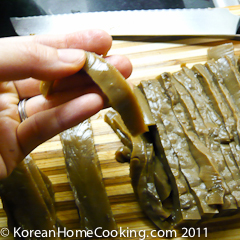 You don't have to cut acorn tofu to look like real noodles. Cut thin, long and flat.
You don't have to cut acorn tofu to look like real noodles. Cut thin, long and flat.
3.
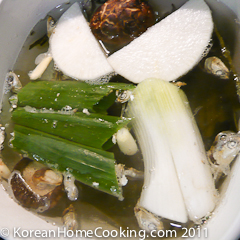 Make anchovy broth by boiling anchovies, kelp, a piece of daikon radish, Korean leek, and dry shitake over high heat at first. Once it starts boiling, take out kelp, add Korean soy sauce and then boil over medium heat for about 20+ minutes.
Make anchovy broth by boiling anchovies, kelp, a piece of daikon radish, Korean leek, and dry shitake over high heat at first. Once it starts boiling, take out kelp, add Korean soy sauce and then boil over medium heat for about 20+ minutes.
4.
 Make seasoning sauce by mixing all the ingredients above.
Make seasoning sauce by mixing all the ingredients above.
5.
 Chop kimchi into small pieces (since they are going to be topping) and season with a dash of sesame oil and ground sesame seeds.
Chop kimchi into small pieces (since they are going to be topping) and season with a dash of sesame oil and ground sesame seeds.
6.
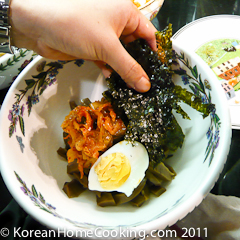 Place the acorn tofu noodles (from Step 2), followed by a half of hard boiled egg and seasoned kimchi (from Step 5) and shredded roasted seaweed. Add sliced or julienned cucumber if available.
Place the acorn tofu noodles (from Step 2), followed by a half of hard boiled egg and seasoned kimchi (from Step 5) and shredded roasted seaweed. Add sliced or julienned cucumber if available.
7.
 Pour the anchovy broth from Step 3 over the noodle pile. Add the seasoning sauce (from Step 4) to your taste right before serving. You can serve it chilled or hot.
Pour the anchovy broth from Step 3 over the noodle pile. Add the seasoning sauce (from Step 4) to your taste right before serving. You can serve it chilled or hot.
8.
 You can also serve it with steamed rice.
You can also serve it with steamed rice.

Photo Source: National Geographic
It's been ten days since a 9.0-magnitude earthquake struck off the coast of Japan. I just saw a special footage on NHK which showed the stark reality of the situation in Japan after the earthquake hit. As I was watching, I couldn't stop thinking how little we are in front of the fearsome power of nature and how grateful we must be with every second we have with our friends and families, in comfort of our home. Some of the scenes captured on video were just too painful to watch. In one scene, I spotted a man stranded on a roof top of a building and then the camera turned away to capture the approaching tsunami nearby, and when it panned back there was only a tall tide of black water to be found where the building had been, as if the scene was taken from a different location... In an interview, an old hospital worker mumbled in teary eyes, that she saw a patient lying on the bed in a hospital with his eyes wide open, and then engulfed in water shortly after. Those who are fortunate enough to survive are devastated emotionally and physically. They pleaded for help as they are in dire need of food and water and warm shelter. Thanks to international relief efforts, there are many ways we can help.

We feel even more close to the Japanese people now since it's been only four months since our first visit to Japan last November and our memories of Japan are still vivid. Memories of kind hospitality we received from the people of Japan always make us want to go back. And I am heartbroken to see the people who lost so much in this terrible disaster. While there are many ways to help the Japanese people now, in a long run I want to encourage people to visit Japan especially if you have never been there.
In this post, I would like to share some of our experiences from our travel to Japan last Fall.


What I liked about Japan the most during our trip was their appreciation for traditional assets and their efforts to preserve them in their most original forms. Unfortunately I find this is something that many countries often neglect as they advance fast towards the state of modernization. And yet Japan sets a very good example to follow in terms of historical preservation.


This includes not only physical assets but also social values such as moral integrity and respect for others. I read somewhere that if you leave a laptop on the street in Japan, it is likely you could find it in the same state the next day where you left it. When I read it, I almost wanted to test it myself. Having lived in New York and the San Francisco Bay Area for the past 10 years, I really wished American cities could one day post such a headline on newspapers, too.


During our trip, we particularly enjoyed staying in a Japanese traditional ryokan in Hakone, a small and quiet hot spring town located about two hours southwest of Tokyo. The ryokan we stayed named Taisekikan, was situated along a creek that runs between picturesque mountains that were fully wrapped in yellow and red foliage. Our room was almost void of any furniture except for a low table in the middle of the room. After we changed to yukata, a casual traditional Japanese lounge wear, we were served a traditional Japanese course meal, kaiseki, which was delicately prepared using fresh seasonal produce. After the dinner we took a traditional bath in the outdoor hot spring attached to the ryokan. The hot spring literally sat next to the creek surrounded by mountains on the side and the starry night sky on top. It was an amazing experience. We really loved this unique experience of staying in ryokan and I strongly recommend to anyone who is planning a trip to Japan.

As a Korean, I want to point out some historic relationships between Korea and Japan. As a matter of fact, Korea and Japan had rarely stayed in good terms in the past history. Japanse colonization of Korea took place in 1910 and lasted for more than 30 years until the end of the Wold War II. During this period, the Japanese colonial regime oppressed Korean human rights and many Korean people suffered or died helplessly. Even today, there is a territorial dispute over Dokdo Island between the two countries. And they are the fiercest rivals in international soccer games, and Korean people go all "Red" whenever there is a game against Japan. Nevertheless, both countries are inseparable neighbors who share many popular cultures, through Korean Wave, J-Pop, Anime, Manga, etc. There is, and will always be this love-and-hate relationship as far as I can see -- I doubt if there is any country in the world that does not have, or has had, any dispute with its neighboring countries. But it's nice to see that Korea is actively lending helping hands to Japan after the disaster. Korean government was quick to send a rescue team to Japan, and civilian supports/donations are flowing in from Korea as well as from the Korean American communities around the world. I too, sincerely wish for the safety and swift recovery for Japan and the victims.

This time in Korea, we had a quite unique experience in Seoul by staying in hanok, a traditional Korean house. We loved staying in hanok so much that we even wished that we could live in one of the hanoks if we ever decide to live in Korea.

It is said that there were over 800,000 hanoks in Seoul until the 1970s, but more than 90 percent were demolished during the post-Korean War era as the Korean society focused the post-war developments on modernizing everything from its economy to people’s living quarters. This was deemed necessary to accommodate the fast-growing population and the economy at the time. As a result, high-rise apartment complexes and shiny office buildings dominate much of the scene in Seoul today, and only a handful of these hanoks survive mostly in Bukchon just north of the city centre (“bukchon” means a norhern village). Somewhat belatedly though, these once-forgotten assets of Korean history have come to Korean people’s attention these days, and many efforts have been made to preserve the remaining hanoks and educating young children about historic preservation. I was surprisingly delighted to find that the hanok we stayed in was beautifully renovated to meet today’s living standard while keeping the authentic beauty of hanok intact. I have to make one disclosure though. Hanoks do not offer the luxurious comfort you may find in hotels, but it does offer magic authenticity which gives you the impression that you walk back in time several hundreds years and let you experience the real life of Koreans back then.

I did a bit of research on hanok stay options in Bukchon before we went. There are several hanoks in Bukchon that offer guest rooms. If you can afford, Rakgojae seems to be the best option as it offers the most authentic hanok experience in a beautiful setting. But their rate was well above our budget, so we ultimately narrowed down the choices to Bukchon Guest House, Tea Guest House, and Sosunjae. The first two are most popular among foreign tourists, and I felt I wouldn't really "fit in" there as a Korean. We wanted to stay in hanoks where locals (Koreans) come to stay.


We stumbled on Sosunjae from a Korean traveller’s blog. Sosunjae is not technically a guest house, but it is rather called a “think museum” where children occasionally come to learn about Korean culture and history in a traditional hanok setting. The place only has one guest room, and it comes with its own bathroom and a library/living room space.

The library is used by children during the day time, but since it’s attached to the guest room you get to use it when it’s not in use. There is no TV or other amenities, so I find it ideal for people looking for quiet hanok stays.


The real bonus to staying in Sosunjae is that the host lady is an excellent cook. We stayed there for three days, and we were served delicious breakfast each morning.

On the last day, since we had to catch the airport limousine bus early in the morning, she packed us delicious rice balls (joomukbap) and water in a bag along with a small jar of home-made apple jam as a gift.

Overall, we really enjoyed staying in hanok and were glad that we decided to stay in hanok instead of hotels. The experience of interacting in space where the Korean culture and history take its roots was priceless. As a Korean American, I felt a sense of belonging and attachment in hanok of my mother country.
How to get there:
It takes about 10 minute walk from Anguk Station via #3 Subway Line which is usually depicted in orange on the map. Or you can use the airport limousine bus which takes you near Anguk station. If you are using the subway, exit through #2 or #3 exit and walk about a mile to the north and make a right towards Joongang High School. Joongang High School is a very famous tourist attraction as it played a backdrop for the famous Korean drama Winter Sonata. Facing Joongang High School, walk past five houses to the right, then you will find stairs to Sosunjae pictured above.
Contact:
011-9853-6627
thinkmuse at naver dot com
Rate:
100,000 won per day (single occupancy)
130,000 won per day (double occupancy)
Requires 30 percent deposit.

We were in Korea and Japan during the last two weeks of November. We spent the first week in Korea mainly touring Seoul and Kangwondo, and spent the the second week in Japan travelling major cities like Tokyo, Kyoto, Osaka and Hakone. Although we missed turkey and Black Friday, we got to celebrate this year's Thanksgiving with the freshest sushi (probably in the world) in Tsukiji Fish Market in Tokyo.
Our original plan was to go to Japan only since we went to Korea last year, but we figured we could combine two of our favorite destinations in one trip since Japan is only 2 hours away by flying from Korea. Luckily, we were able to make this arrnagement with the airline at no extra charge. We loved the fact that there was another trip to look forward to at the end of one trip. It definitely doubled our excitements.

It turned out November is a beautiful time to visit either country. While we got to see a glimpse of fading foliage and lots of fallen leaves on the streets in Korea, in Japan they were just about beginning to paint their leafy mountains. When we checked the weather prior to departure we were expecting rain, but what waited us was sun drenched days with the crisp bite of fall air most of the time.

The trip to Japan was especially memorable and fun-filled because we travelled with friends (a couple) whom we’ve been friends with since college. This was our first time travelling abroad with friends, so we were not sure whether we would come back as the worst enemies or as the best friends at the end of the trip. I think we came back as the best travel buddies. We realized that there are many benefits of travelling together with friends including splitting the cost of shared services, getting discounts at ryokan, or having someone to take pictures of you, but the best part was that there is always someone whom you can share the joys of travelling with.
Min has just finished processing the photos we took from Korea and Japan. Please feel free to click through. I plan to post more photos and entries about our trip, but it will take some time to organize. Meanwhile, here are some teasers.
 traditional Korean kitchen
traditional Korean kitchen
 Seoul at sunset
Seoul at sunset
 biking in Kyoto
biking in Kyoto
 art work in Seoul
art work in Seoul
 yogiya cafe in Kyoto
yogiya cafe in Kyoto




















































